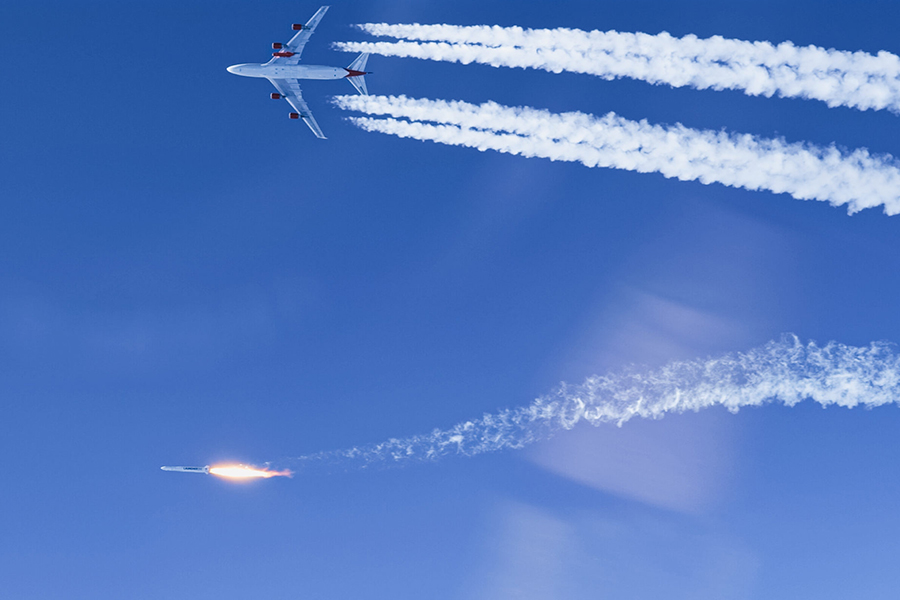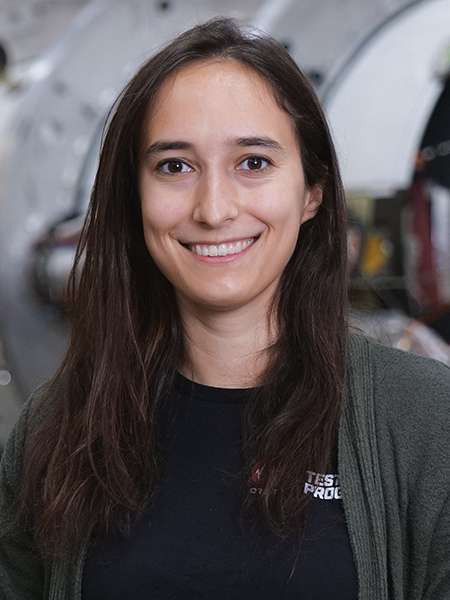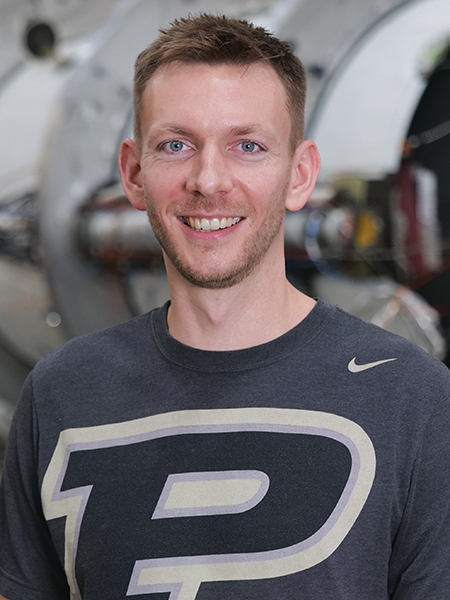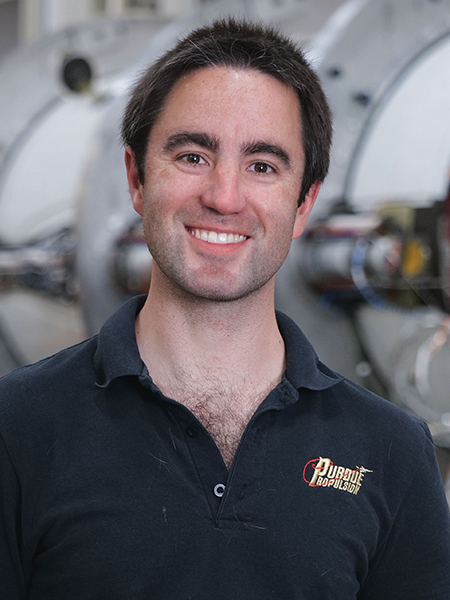AAE alumni play key roles in successful Virgin Orbit launch

Dayle Alexander is unabashedly a “space nerd,” evidenced at a young age by six trips to Space Camp.
Steven Hunt simply knew he’d build rockets and thought, maybe, he would even support one live.
Matthew Wierman grew up near Florida’s Space Coast and has been passionate about rockets and space since he was 9 years old.
When Virgin Orbit’s air-dropped LauncherOne rocket reached space during the company’s second launch demonstration on January 17, it wasn’t only a statement for the company punctuating its arrival in the growing small-satellite launch market. Which, of course, it was.
The successful launch and each of the pieces that went into such a feat were a culmination of nearly nine years of intense, relentless, thorough work. At times during that span, improvement was driven by failure — a premature shutdown of the first stage’s engine cut the first test flight short in May 2020. But that only served to make January’s achievement of becoming the first private company to send a liquid-fueled, air-launched rocket into orbit even sweeter, as it validated visions for so many involved in the achievement.
People like School of Aeronautics and Astronautics alumni Alexander, Hunt and Wierman.
“The experience was kind of what I had always dreamed of, honestly,” Hunt said.
Alexander was stoked to be able to say she was part of a “space first.”
Wierman still has a sense of wonder and awe, weeks after the launch.
“Ever since I was a little kid, I wanted to put something in space, and I finally got to do that,” Wierman said. “I look up in the night sky and know there are 10 small satellites that are orbiting the Earth because of what I and the rest of the team did.”
Alexander, Hunt and Wierman were imperative toward the success of the Launch Demo 2 mission, but they weren’t the only ones. And they weren’t the only Purdue connections.

On Jan. 17, there were 11 Purdue alumni working full time at Virgin Orbit, according to the company. Ten of those are AAE graduates: Alexander, Hunt, Wierman, Pau Pineda Bosque (BSAAE ’18), Eric Briggs (BSAAE ’03, MSAAE ’05), Jamie Eckstein (MSAAE ’08), Nicholas Foster (MSAAE ’20), Winni Wei (MSAAE ’13), Eric Wernimont (BSAAE '85, MSAAE '91, PhD AAE '97) and Nick Zarbo (MSAAE ’15). Giovanny Guanche Silva received his bachelor’s in 2014 from the School of Materials Engineering. (Wernimont left the company Jan. 21.)
The significant community of Boilermakers at the private California-based satellite launch company is not lost on those within it. A group of alumni gathered outside Virgin Orbit’s Long Beach facility on Feb. 1 for a photo, and someone joked, “The whole propulsion department is here.”
“We’re a company of about 600 people. To look at a school that’s 2,000 miles away and realize we have 10 employees from that school, that doesn’t really happen by accident,” Hunt said. “It says something about the school.”
That it is special.
That it has grown to world prominence in education and researching by establishing a tradition of excellence earned by dynamic faculty and students who achieve what few thought was attainable.
That it continues to solidify its position as one of the world’s top producers of aerospace engineers, graduating students who not only have a firm grasp on engineering fundamentals but have spent years in practical application to best prepare them for careers in the industry.
That it is insistent to move beyond the theoretical and provide more — unique hands-on experimental testing opportunities at a facility like Maurice J. Zucrow Laboratories, the nation’s largest university propulsion lab. The lure that enticed Alexander, Hunt and Wierman. And so many others.
“It’s exciting,” Wierman said of having so many Boilermakers at Virgin Orbit. “It’s a testament to the program that is at Purdue. I remember when I was looking at grad schools and trying to figure out where I wanted to go to pursue my studies in actual rocket combustion, it was very clear to me that I want to do experimental work and the only place that I could do that to the extent I wanted to was at Purdue. Zucrow Labs is second to none. The program that’s been put together there is darn impressive.”
Alexander (BSAAE ’16, MSAAE ’18), Hunt (PhD AAE ‘16) and Wierman (MSAAE ’10, PhD AAE ’14) offer three perspectives on the special day for Virgin Orbit, how AAE alumni helped fuel the mission and the impact of Zucrow on their burgeoning careers:
Dayle Alexander
One month after Alexander completed her master’s degree from AAE in 2018, she started at Virgin Orbit as a propulsion development engineer. She works on the NewtonFour team as the responsible engineer for several components and combustion devices on that second stage engine for LauncherOne. Considering the size of the company, she has her hand in other areas, too, like reviewing data and trouble shooting important components after hot fire tests, among other things. But wide range of experiences is exactly what she was hoping for out of Purdue — and what attracted her to Virgin Orbit initially.

“It turns out within my first couple of weeks, I was given responsibility of a really important combustion device on the engine. That was really cool for me, that I was given so much responsibility off the bat,” she said. “It taught me a lot because that part, it’s actually a 3D-printed part, so there was a bunch of materials research that had to go into it and development with the printer and everything like that. So I’ve had to learn a lot of stuff.”
After spending a lot of the last year working on troubleshooting and the failure investigation from the first flight, Alexander was eager to plop down in her apartment in Long Beach with boyfriend Matthew Zweige, a contract employee for Virgin Orbit who also is a Boilermaker (BSAET ’16), to watch the livestream on January 17 of the second test.
With the fading trail of the first stage in the sky visible outside, she was waiting to see the second stage ignite and wanted to see the rocket in space. Especially considering the first rocket didn’t make it there. Then she watched it happen.
“This is the first thing I’ve ever touched that has made it to space. So just for me as a space nerd, I just thought that part was really cool,” she said. “When you started to see on the livestream that the sky was black instead of blue, that was just really, really cool. Then you heard it on the comms system that we were in space, that part was unforgettable.”
But just reaching space wasn’t the end goal.
Beside just the NewtonThree main stage engine igniting and having a good first burn, the team also was waiting to see the second burn, after coasting in space. She was holding her breath. For an hour.
“We didn’t even have live data for that, so we had to wait until it actually happened to get confirmation that it did happen, so that was pretty nerve-wracking.”
Once confirmation came, Skype for Business lit up. A small group of propulsion and integration engineers who live near the beach ran there to share the joy in person. They were socially distanced and wearing masks, of course, but still able to see faces and hear excitement in voices.
“It was a really neat day,” Alexander said, “and likely one I’ll never forget.”
One she was able to play a role in, partly, because of her AAE education and exposure to Zucrow. She knew she wanted hands-on experience, so she stayed at Purdue for grad school, advised by AAE Professor Stephen Heister. And the experience proved invaluable.
“There are some things you can’t get in a classroom,” Alexander said. “Just the fact that you know what a turbopump looks like and know how to calibrate a pressure transducer. Or you know what to look for in the plume of the engine or the data you’re looking at. Seeing that not for the first time when you start your first job is just so important.”
Steven Hunt
Looking back on it, Hunt wishes he’d worn a heart rate monitor.
Some of his friends who have done launch support for other companies have done it, and Hunt always has been interested to hear the results. He can only guess what his output was on Jan. 17.

“I don’t think my heart rate ever went down until NewtonFour commanded its first engine shutdown,” Hunt said. “By then I was feeling, like, ‘OK, today is a good day.’”
Most of Hunt’s job as a senior propulsion engineer involves doing analysis on propulsion systems to understand how fluid dynamics and thermodynamic phenomena will affect the rocket. For this specific launch campaign, he also did operations work, helping develop operations and procedures for launches and tests. He also sat on console during the launch and monitored the second stage propulsion systems in real time.
In mid-January, he was in an “extremely distanced mission control” — COVID prevented a conventional mission control setup, a room jammed with people closely watching screens — monitoring the stage two propulsion systems during different phases. That included monitoring the liquid-oxygen systems, the propulsion systems during the “captive carry” when the rocket is aboard CosmicGirl, the 747 carrier plane, and the propulsion systems after LauncherOne was dropped and the first stage was lit.
Once the rocket was dropped, Hunt’s role was somewhat diminished because the rocket was on its own at that point. But that doesn’t mean he walked away. He stayed in the large office area he was sequestered in until there were only a few people still in the building, but, even distanced, he still felt reverbs.
“There is no exaggeration to this, the distance was a bit far, but they were loud,” he said of the celebration after the completed mission. “They were excited.”
As they should be.
“For Virgin Orbit, this was important because we transitioned from a field of companies with rocket concepts, which is honestly a crowded field, to a field of companies that have a working rocket and have made it to orbit. That’s a very small field,” Hunt said.
Hunt said he is “beyond grateful” for the opportunity to go to Purdue, and he appreciated the rigorous education provided by the top-tier school. But, for him, there was a clear selling point: Zucrow.
“Any school can have good theoretical education if they have a good faculty, but to have the hands-on experimental testing opportunity, they need to invest the infrastructure. I would dare anybody to find a better rocket testing facility or aerospace experimental facility than Zucrow labs at Purdue,” said Hunt, whose advisor was Heister. “That’s not normal. It’s a unique place. I was really fortunate to have been able to go there.
“I’m understating that it was huge for my career.”
Matthew Wierman
Wierman started at Virgin Orbit in 2015, when it still was conducting activities as a division of Virgin Galactic. Sir Richard Branson announced the creation of Virgin Orbit as its own company in 2017. Wierman can remember when there was a group of 60 people barely filling the building in Long Beach that now is, in some ways he says, “bursting at the seams.”
It’s given Wierman insight and perspective into the immensity of the painstaking process to get to January 17.

“Over the years as we’ve made improvements to the system and getting to that first launch, each step of the way from engine test, to stage test, to flight test with the plane, flight test with the plane and a test rocket, all the way to our testing with the rocket last year, we learned a great deal in all of our operations,” he said. “We got some really good data in the pull-up maneuver, the drop, the first ignition, and then all the learning and work we did in failure investigation ultimately made a better engine and a better vehicle that we ultimately flew a couple weeks ago.
“It’s been a huge team effort, the whole way through.”
As a senior propulsion design and analysis engineer, Wierman works on the NewtonThree engine. He is a responsible engineer for engine testing and goes to the Mojave test site to direct engine test operations. He determines the next test that will be run and what work needs to be done on the engine. He sits on console and looks at engine data live during engine tests and makes go/no-go calls with the test team.
On the day of the second launch demonstration, Wierman didn’t have any immediate responsibilities, but, like the rest of the company, he watched the internal livestream closely, sitting in his backyard with his wife. At each milestone, he was bursting with pride, knowing the ramifications for the company.
“For the company as a whole, this is what we’ve been working toward, trying a new entry to space with a liquid propellant, air-dropped rocket that we can launch anywhere in the world,” he said. “It’d be fun to someday say, ‘Hey, can I go support launch ops in Guam? I hear the scuba diving is nice.’ To enable that access and trying different things, we now have an engine system that works. There’s a saying that we often say in engineering that better is the enemy of good enough, but we have now identified improvements that we can make that are real, good, sensible improvements to the vehicle that we can go forward and make a better vehicle for our customers, a better vehicle for our bottom line and, as an engineer the most exciting part, a better vehicle technically that we can actually try new things.”
Trying new things is an engineer’s dream — and that appetite was satiated during Wierman’s time at Purdue.
Running a test cell at Zucrow, working under advisor Bill Anderson, allowed Wierman to have a hand in the design, the operation, the maintenance and the actual testing. He was building up a knowledge base for the entire process, and learning how to communicate all the needs along the way.
All the work he was doing, he found, was directly transferable once he left Purdue.
“Having that experience at Zucrow of being the person who is not only analyzing the data but also running the test and getting yourself up under the test articles to fix them, it makes you appreciate not only the high-level design work but also the boots on the ground, of turning the wrenches,” he said. “One of my main responsibilities as a responsible engineer is just writing work instructions and saying, ‘OK, we need to replace this transducer, and that means you need this part number, it needs to be checked out to this standard …’ and understanding the technicians, they have to take my instructions and do them. I need to be able to communicate the exact way I want them to do it. The experience at Zucrow was helpful because I had to do that myself.”
